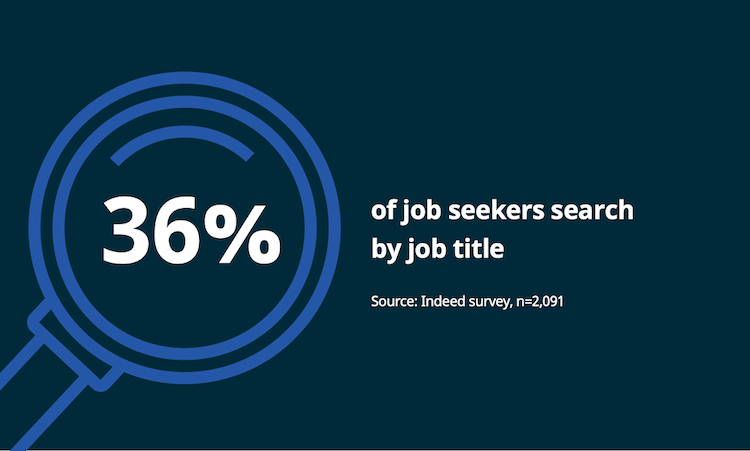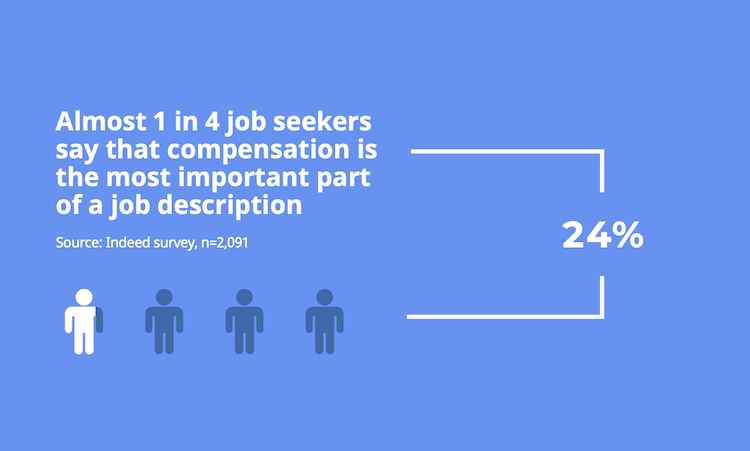Job Description Best Practices
Optimize your new and existing job descriptions to reach more candidates
Get the Guide
How job seekers search for jobs on Indeed
Similar to how you have requirements for candidates, job seekers also have requirements for employers. Without having certain information about your open job(s), job seekers can’t be sure if the job description meets their requirements.
When job seekers are looking at a job description on Indeed, they are typically asking themselves these two questions:
- Am I a fit for this job?
- Is this job a fit for me?
If either or both of these questions are a “no,” then they will likely move on — and the quicker they can answer these questions, the better. If your job posting doesn’t have what job seekers are looking for, qualified candidates might not apply to the job because they aren’t sure if it’s a good fit.
Other job seekers might apply to the job regardless of knowing whether it’s a good fit, only to realize later they aren’t qualified or not interested, which can contribute to application quality issues.
What job seekers are looking for in a job post
At Indeed, we analyze trends to learn what specific details most job seekers are looking for when searching for their perfect job. We’ve found that if you don’t include certain key pieces of information job seekers care about, you may miss out on quality applicants.
Here is the most important information you should consider including for any job you post.
A descriptive job title
Job titles are key to making sure your role is compelling to people searching for a role that suits their needs. Think like a job seeker. Job seekers search for jobs by entering the what and where on Indeed. When they enter the “What” (the job they’re interested in) in Indeed’s search bar, we prefill industry-standard terms and terms with the most job posts.

We’ve found that 36% of job seekers that use job sites search for a job using the exact title of the job they’re looking for.

Salary or salary range
For job seekers, salary is one of the top factors that determine whether a job is worth seriously considering. In fact, an Indeed survey found that 24% of job seekers say that compensation is the most important part of a job description.
However, when asked how often they saw job postings with compensation information during their current or most recent job search, 12% said “never” and 57% said only “occasionally.”

Another Indeed survey found that nearly half (49%) of job seekers said what led them to look for a new job was a better salary than their previous job. This suggests that some job seekers avoid applying for jobs that don’t list a salary range, since they can’t determine if the job will come with a raise. That means you might miss out on qualified candidates. Other job seekers apply and find out later that the job doesn’t meet their salary requirements, leading to wasted time on both sides.
To make things easier for both you and your candidates, consider including a salary or salary range in your job posting.

Job type
People need jobs that fit into their lives. Often, job seekers aren’t flexible on the type of job that they’re looking for (e.g., full-time, part-time, contract, freelance, temporary).
Make sure to include details about the job type for every job you post to make sure you’re attracting candidates that are a good fit.

Shift information
Job seekers have certain schedules that their job must fit into. Without knowing shift information, job seekers are left assessing whether it’s worth their time applying to a job that may not end up working with their life.
For example, let’s say a qualified candidate is looking at your job post. However, they’re only available to work night shifts. Without shift information listed, they decide to go ahead and apply and then figure out what the shift is going to be. If the job is not for a night shift, there will be a mismatch that could’ve been prevented before this candidate applied.
Include shift information in your job posting — and be specific. For instance, if you just say “part-time, hourly,” those hours could be anywhere within a 24-hour period. Consider including one or more of these relevant keywords in your job posting to clarify the shift:

Requirements
Job seekers look at job requirements to assess whether or not they qualify for the position, as they usually don’t want to waste time applying for a job they’re unlikely to get. Consider splitting job requirements into must-haves vs. nice-to-haves to let candidates know what the minimum qualifications are upfront.
Keep in mind that must-haves should be hard requirements for the role. It’s also a good idea to trim down your list of must-have requirements since long lists of qualifications can discourage qualified candidates from applying. For example, does a candidate really need to have a bachelor’s degree to succeed in the role?
You can also use screener questions to help job seekers further self-qualify. Screener questions are short questions designed to help you determine if an applicant meets your minimum qualifications. Examples include “Do you have a valid [license type]?” and “How many years of experience do you have in XYZ?”

Screener questions can be helpful for job seekers because it allows them to know, at a glance, if they’re qualified for the position before reading more about the job description.
If they don’t meet the minimum requirements, they are less likely to apply for the job. Nearly 54% of small business employers who include screener questions with their Indeed job post reported receiving a qualified applicant within a day.
Benefits
According to an Indeed survey, 42% of job seekers said a “variety of benefits” is what most attracts them to a new job. Another survey found that most job seekers (83%) agree that a company’s benefits and perks have a significant impact on their decision of whether or not to accept a job offer there.
Certain job seekers are the primary benefits provider so they may not consider a job if the benefits don’t align with their family or personal needs. Including a selection of your top benefits and perks in your job posting can also help you stand out from the competition.

Street address
Calculating the commute time is part of the job seekers’ process for deciding to apply for jobs. Job seekers often rule out positions if they’re not within a certain commute time. Without a specific location listed, job seekers then have to research the company, which makes their job search less efficient.
Instead of listing the general metro area or city, add your street address so job seekers know exactly what part of town you’re in and what their drive or commute might look like. An ideal street address consists of a street number, street name, city, state and zip code.

If your job is fully remote, you can choose “Remote” as your location.

If you have a hybrid workplace (i.e., employees can choose whether they work remotely or from your physical location), you can sponsor your job to advertise it in multiple locations.

Format your job posting to appeal to job seekers
A well-formatted job description indicates to the job seeker that you’ve put effort into creating the job description. According to an Indeed survey, over half (52%) of job seekers say the quality of a job description (e.g. spelling, grammar, formatting) is “very” or “extremely” influential on their decision to apply for a job.
When adding these details to your job description, make sure it’s relatively short and easily scannable. The typical job seeker is often completing other tasks (picking up kids, at the doctor’s office, on lunch break, etc.) while they are looking for jobs. You want to capture their attention quickly. In fact, job seekers most commonly stated that they spend only 3-5 minutes reading a job description before deciding whether or not to apply.
This includes:
- Listing qualifications as easily consumed bullet points
- Avoiding large walls of text
- Only including information that is absolutely necessary
- Avoiding putting vital information at the bottom of the listing
Need help updating your job description? Use one of our many job description templates with samples of actual job postings for your next posting. You can also try Indeed’s AI Job Description Generator to quickly create a clear and concise draft based on your role details.
Get better visibility by sponsoring your job
Another great way to attract the right talent is by sponsoring your job on Indeed. When you sponsor your job, it will appear more often in search results than a free* listing.
*Terms, conditions, quality standards and usage limits apply
Back to Hiring with Indeed
*Indeed provides this information as a courtesy to users of this site. Please note that we are not your recruiting or legal advisor, we are not responsible for the content of your job descriptions, and none of the information provided herein guarantees performance.
This article is based on product information available at the time of writing, which may change at any time. Indeed does not guarantee that this information is always up-to-date. Please seek out your CS/Sales rep for the latest on this topic.
















